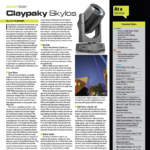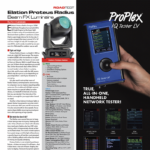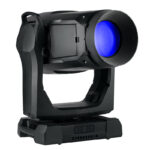Despite their name and long association with lighting primarily meant for clubs and smaller venues, ADJ Lighting has released a number of professional touring fixtures recently. Their Vizi line includes lights with feature sets normally seen on larger-format lights, but with attractive price points set to be within reach of houses of worship and other facilities or productions that need to be conscientious with their budget.
Today we’re looking at the Vizi Hybrid 16RX, a moving head for people who need a lot of functionality from a single package. Perhaps somewhat surprising is that this is not an LED-based unit. LEDs simply do not have the lumens to compete with the raw power of these very short arc lamps, something manufacturers have taken advantage of recently.

Under the Hood
The 16RX is powered by a Philips Platinum 16R discharge lamp, a 330-watt lamp, which comes pre-focused in its reflector. The native Correlated Color Temperature (CCT) of this lamp is 8000 Kelvin, which is a touch on the bluish side. Lamp change is accomplished by unscrewing two screws that hold on the lamp access plate on the rear of the unit. These screws stay captive while changing the lamp, but the entire process is somewhat complicated so I wouldn’t attempt it while the unit is in the air. Ultra short-arc lamps like these have some demanding cooling requirements, so there are two large fans on either side of the lamp housing, directing cool air in to keep the lamp within thermal tolerances. These seemed to do a good job, and I didn’t notice any lamp flicker from envelope temperature variations. In terms of brightness, I measured 21,600 lux at 5 meters at 50 percent zoom and the center of the hotspot, a respectable output.
Immediately after the angled hot mirrors are a pair of dimmer and strobe flags. These are simple metal flags with a sine wave pattern, each with their own separate motor. The dimming law on this light is somewhat strange, with nothing really happening until you get to around 50 percent on the dimmer, at which point it goes down steeply and closes completely around 17 percent. This is exacerbated by having a relatively peaky beam profile; there’s a pronounced hotspot in the center of the field that the dimmer flags don’t reach until they’re more than halfway closed, which also results in significant vignetting. That said, this light is intended primarily for producing aerial effects, so the intended users may not worry too much about not being able to produce very slow, subtle fades. The strobe function provides pulses, random, and synchronized strobes, and all the strobes were nice and crisp.
Next after the dimming flags is the color wheel. The filters are glued into place on the wheel and so are not user-replaceable. There’s a great selection here, with 14 dichroic colors plus open. Gaps between adjacent colors are extremely small, producing very usable split colors. The first half of the color wheel DMX range is dedicated to “snaps” between colors and split colors, while the second half is completely indexing. This allows users to do smooth fades between adjacent colors, which is useful for more subtle color changes. There’s a good range of saturated colors and pastels here, and several adjacent colors would make for excellent chases or effects.

Also on this module are two gobo wheels, a stamped metal fixed gobo wheel with 16 patterns plus open and a rotating gobo wheel of 12 patterns. The fixed gobo patterns include a variety of gobos optimized for use with either of the prisms as well as some aperture reducers and a frost position. The rotating patterns, somewhat unusually, were all colored; there are no black and white gobos here. A lot of designers have very strong opinions on gobos in general and colored gobos in particular, but gobo selection is never something everyone agrees on. To facilitate different tastes, all the rotating gobos are user-replaceable and use the familiar slot-and-lock system, for those who wish to change them out for their own patterns. The rotating gobos are surprisingly small, just seven millimeters across, but the level of detail is very good. Due to a large carrier, there is a somewhat pronounced blackout between patterns, but the change itself is snappy. Pulling gobo focus — morphing from one gobo to another — is very effective with this light.
After the gobo and color module are the moving lens elements, two prisms, and the frost filter. The frost nicely smoothes out the field, turning the output into a nice wash effect for times when you need a soft edge. This effect is not variable, it’s all-or-nothing. Prisms consist of an eight-facet circular prism and a linear prism, and these can be overlaid in the output at the same time. The linear prism exhibits a certain amount of center-to-edge falloff, but this is normal for prisms of this type. Both prisms provide good image separation and can be both indexed and rotated.

An interesting thing to note here: due to the position of both the prisms and the frost flag in the optical train, inserting any of these three effects will cause the moving zoom elements to move to their narrowest position to make room for them. This overrides the zoom function and restricts it to a very small range the entire time the prisms or frost are in, something to be aware of when programming. Full zoom range is a very respectable 3° to 32°, and is snappy enough to get some good dynamic effects. Pan and tilt speed are good, taking 1.66 seconds for a full 270° tilt movement and 2.9 seconds for a full 540° pan movement, which should be fast enough to satisfy most users.
This unit is somewhat friendly in terms of serviceability. The only module that can be removed is the gobo and color module, which involves removing a fan and several non-captive screws and is not a process I would attempt while a fixture is in the rig. Fixture functions can be set from the front display, a simple LCD panel with four buttons for addressing and options.
From a cold start, the unit takes 30 seconds from home to final output, and when reset, it starts to output light before reaching its final pan and tilt position. Users should take care to black out the fixture before resetting. The unit is 22.4 inches tall with a base that is 12.7 by 14.5 inches, and weighs in at 51 pounds. Rigging is via the extremely familiar Omega-style brackets that attach to the bottom of the fixture with a simple quarter-turn. Power input is via a Neutrik PowerCON connector and auto-ranges from 100V to 240V. A dual road case, the DRC16RX, is also available for storage on the road.

At a Glance
Multifaceted, Versatile, and Within Reach
The Vizi Hybrid 16RX enters a busy sector of the marketplace, competing against multiple other units that offer multiple functions in a single unit. Where it succeeds is in simplicity of use and multiple effects that allow it to operate as a very versatile fixture, from a wash to a spot to a beam. Whether it finds use in a club or DJ or touring rig, it should be at home anywhere a light that can fulfill several roles is needed.
ADJ Vizi Hybrid 16RX
PROS:
- Affordable price, decent brightness, many gobo patterns.
CONS:
- Uneven dimming, prisms and frost restrict zoom range.
STATS
- Size: 22.4” x 12.7” x 14.5”
- Weight: 51 lbs.
- Power: 573 watts
- MSRP: $2299.99
- Manufacturer: ADJ
- More Info: www.adj.com



